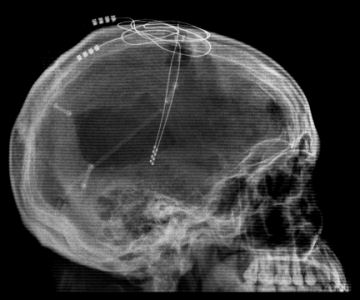The electric brain
Electrical implants allowed a brain-damaged man to talk, eat, and move again.
By Emily Sohn
It sounds like a miracle: A man with severe brain damage regained the ability to talk, eat, and move after doctors implanted an electrical device deep inside his brain.
Since suffering a brain injury 6 years ago, the man had barely responded to the world around him. He couldn’t eat, so tubes delivered nutrients to his body. When asked yes-no questions, he sometimes moved his eyes and thumbs, but his responses were not consistent.
 |
|
This X-ray image shows the electrodes that were placed in the head of a brain-injured man, allowing him to talk, eat, and move again.
|
| The Cleveland Clinic |
During a 10-hour operation, neurosurgeon Ali Rezai put two devices called electrodes deep within the center of patient’s brain, in an area called the thalamus.
Shaped like a walnut, the thalamus serves as the brain’s “grand central station,” says Rezai. It helps signals travel between the brain and the body’s sensory organs, such as the eyes, skin, and tongue.
Electrodes transmit electric currents. Rezai and colleagues proposed that transmitting currents deep in the brain would make the thalamus more active. And firing up the thalamus, they suspected, would wake up the whole brain.
“We’re essentially jump-starting the brain,” Rezai says.
Still, the doctors didn’t know for sure if the treatment would help the patient.
It didn’t take them long to find out. Immediately after the surgery, the man opened his eyes and began responding to voices. Over 6 months, his doctors turned the electrical stimulation on and off to see what effects it was having. The patient never knew if the implanted device was on or not. These repeated tests proved that the patient’s improvements were due to the stimulation of currents transmitted by the electrodes.
The man remains severely disabled. His muscles are extremely weak from years of disuse. Still, he can do some of the motions involved in brushing his teeth and drinking from a cup, which he could not do before.
The doctors now plan to test deep-brain electrodes on 11 more patients who also have severe brain damage. The results, they hope, will be just as encouraging.—Emily Sohn
Going Deeper:
Vastag, Brian. 2007. Waking up: Brain stimulator spurs dramatic improvement years after injury. Science News 172(Aug. 4):67-68. Available at http://www.sciencenews.org/articles/20070804/fob2.asp .
To see an animated clip showing how deep brain stimulation works, click here. (17 MB .MOV file. Broadband connection strongly reccomended.)







